Evidence for vesicle-mediated antigen export by the human pathogen Babesia microti
- PMID: 31196872
- PMCID: PMC6572159
- DOI: 10.26508/lsa.201900382
Evidence for vesicle-mediated antigen export by the human pathogen Babesia microti
Abstract
The apicomplexan parasite Babesia microti is the primary agent of human babesiosis, a malaria-like illness and potentially fatal tick-borne disease. Unlike its close relatives, the agents of human malaria, B. microti develops within human and mouse red blood cells in the absence of a parasitophorous vacuole, and its secreted antigens lack trafficking motifs found in malarial secreted antigens. Here, we show that after invasion of erythrocytes, B. microti undergoes a major morphogenic change during which it produces an interlacement of vesicles (IOV); the IOV system extends from the plasma membrane of the parasite into the cytoplasm of the host erythrocyte. We developed antibodies against two immunodominant antigens of the parasite and used them in cell fractionation studies and fluorescence and immunoelectron microscopy analyses to monitor the mode of secretion of B. microti antigens. These analyses demonstrate that the IOV system serves as a major export mechanism for important antigens of B. microti and represents a novel mechanism for delivery of parasite effectors into the host by this apicomplexan parasite.
© 2019 Thekkiniath et al.
Conflict of interest statement
The authors declare that they have no conflict of interest.
Figures
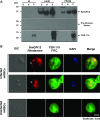
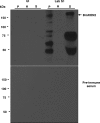
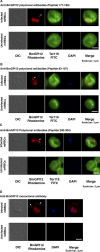


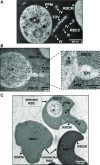
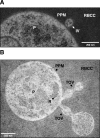
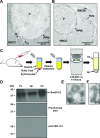
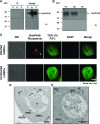

Similar articles
-
Antigen Discovery, Bioinformatics and Biological Characterization of Novel Immunodominant Babesia microti Antigens.Sci Rep. 2020 Jun 12;10(1):9598. doi: 10.1038/s41598-020-66273-6. Sci Rep. 2020. PMID: 32533024 Free PMC article.
-
Structural and Functional Characterization of the 28 kDa Structured Core of BmSA1, the Major Surface Antigen of Babesia Microti.Proteins. 2025 Sep;93(9):1657-1671. doi: 10.1002/prot.26836. Epub 2025 May 9. Proteins. 2025. PMID: 40345974 Free PMC article.
-
Human babesiosis: Indication of a molecular mimicry between thrombospondin domains from a novel Babesia microti BmP53 protein and host platelets molecules.PLoS One. 2017 Oct 17;12(10):e0185372. doi: 10.1371/journal.pone.0185372. eCollection 2017. PLoS One. 2017. PMID: 29040286 Free PMC article.
-
Vaccination against babesiosis using recombinant GPI-anchored proteins.Int J Parasitol. 2019 Feb;49(2):175-181. doi: 10.1016/j.ijpara.2018.12.002. Epub 2019 Jan 24. Int J Parasitol. 2019. PMID: 30684517 Review.
-
Babesia microti: from Mice to Ticks to an Increasing Number of Highly Susceptible Humans.J Clin Microbiol. 2017 Oct;55(10):2903-2912. doi: 10.1128/JCM.00504-17. Epub 2017 Jul 26. J Clin Microbiol. 2017. PMID: 28747374 Free PMC article. Review.
Cited by
-
Identification and characterization of extracellular vesicles from red cells infected with Babesia divergens and Babesia microti.Front Cell Infect Microbiol. 2022 Oct 7;12:962944. doi: 10.3389/fcimb.2022.962944. eCollection 2022. Front Cell Infect Microbiol. 2022. PMID: 36275032 Free PMC article.
-
Four-Dimensional Characterization of the Babesia divergens Asexual Life Cycle, from the Trophozoite to the Multiparasite Stage.mSphere. 2020 Oct 14;5(5):e00928-20. doi: 10.1128/mSphere.00928-20. mSphere. 2020. PMID: 33055261 Free PMC article.
-
An Overview of Current Knowledge on in vitro Babesia Cultivation for Production of Live Attenuated Vaccines for Bovine Babesiosis in Mexico.Front Vet Sci. 2020 Jun 26;7:364. doi: 10.3389/fvets.2020.00364. eCollection 2020. Front Vet Sci. 2020. PMID: 32671114 Free PMC article. Review.
-
Epitope profiling of monoclonal antibodies to the immunodominant antigen BmGPI12 of the human pathogen Babesia microti.Front Cell Infect Microbiol. 2022 Nov 25;12:1039197. doi: 10.3389/fcimb.2022.1039197. eCollection 2022. Front Cell Infect Microbiol. 2022. PMID: 36506011 Free PMC article.
-
Identification of Babesia microti immunoreactive antigens by phage display cDNA screen.Infect Immun. 2024 Jul 11;92(7):e0021524. doi: 10.1128/iai.00215-24. Epub 2024 Jun 17. Infect Immun. 2024. PMID: 38884473 Free PMC article.
References
-
- Abraham A, Brasov I, Thekkiniath J, Kilian N, Lawres L, Gao R, DeBus K, He L, Yu X, Zhu G, et al. (2018) Establishment of a continuous in vitro culture of Babesia duncani in human erythrocytes reveals unusually high tolerance to recommended therapies. J Biol Chem 293: 19974–19981. 10.1074/jbc.ac118.005771 - DOI - PMC - PubMed
-
- Baranyai T, Herczeg K, Onodi Z, Voszka I, Modos K, Marton N, Nagy G, Mager I, Wood MJ, El Andaloussi S, et al. (2015) Isolation of exosomes from blood plasma: Qualitative and quantitative comparison of ultracentrifugation and size exclusion chromatography methods. PLoS One 10: e0145686 10.1371/journal.pone.0145686 - DOI - PMC - PubMed
-
- Ben Mamoun C, Allred DR (2018) Babesiosis In eLS. Chichester: John Wiley & Sons, Ltd.
-
- Boddey JA, O’Neill MT, Lopaticki S, Carvalho TG, Hodder AN, Nebl T, Wawra S, van West P, Ebrahimzadeh Z, Richard D, et al. (2016) Export of malaria proteins requires co-translational processing of the PEXEL motif independent of phosphatidylinositol-3-phosphate binding. Nat Commun 7: 10470 10.1038/ncomms10470 - DOI - PMC - PubMed
-
- Chen TK, Ben Mamoun C, Krause PJ (2015) Human babesiosis In Clinical Infectious Disease. Schlossberg D. (ed) Cambridge: Cambridge University Press; pp 1295–1301.
Publication types
MeSH terms
Substances
Grants and funding
LinkOut - more resources
Full Text Sources
